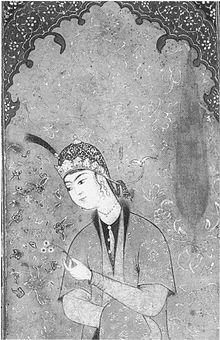| Pari Khan Khanum پریخان خانم | |
|---|---|
 Painting of a seated princess, most likely Pari Khan Khanum[1] | |
| Born | August 1548 Ahar, Iran |
| Died | 12 February 1578 (aged 30) Qazvin, Iran |
| Betrothed | Badi-al Zaman Mirza Safavi |
| Dynasty | Safavid |
| Father | Tahmasp I |
| Mother | Sultan-Agha Khanum |
| Religion | Shia Islam |
Pari Khan Khanum (Persian: پریخان خانم, romanized: Pariḵān Ḵānom; August 1548–12 February 1578) was a Safavid princess, daughter of the second Safavid Shah, Tahmasp I and his Circassian consort, Sultan-Agha Khanum. From an early age, she was well-loved by her father and was allowed to partake in the court activities, gradually becoming an influential figure who attracted the attentions of the prominent leaders of the militant Qizilbash tribes.
She played a central role in the succession crisis occurring after her father's death in 1576. She was able to eliminate her brother Haydar Mirza and his supporters and enthrone her favoured candidate, Ismail Mirza, as Ismail II. However, despite her expectations, Ismail curtailed her power and put her in a house arrest. He died suspiciously in 1577 from poisoning, and Pari Khan may have been the mastermind behind his assassination.
With her endorsement, her elder brother Mohammad Khodabanda was chosen as Ismail's successor. Mohammad was almost blind, and this fact made him a suitable choice for Pari Khan, who expected to lead a de facto rule while Mohammad remained a figurehead. However, his influential wife, Khayr al-Nisa Begum, emerged as an opponent to Pari Khan and successfully plotted her death. Pari Khan was strangled to death on 12 February 1578, at the age of thirty.
Regarded as the most powerful woman in the Safavid history, she was praised by her contemporaries for her intelligence and competence, though in later chronicles she was portrayed as a villain who murdered two of her brothers and aspired to usurp the throne. She was a patron of poets, her most well-known beneficiary being Mohtasham Kashani who wrote five eulogies in the praise of Pari Khan. Writers of the time dedicated works to her, like Abdi Beg Shirazi and his Takmelat al-akhbar and she was compared to Fatima, the daughter of Muhammad, prophet of Islam. In a society that imposed harsh restrictions on high-class women, Pari Khan was able to take leadership of the ineffective Safavid court and gather royal followers amounting to four or five hundred.
- ^ Soudavar 2000, pp. 60, 68.